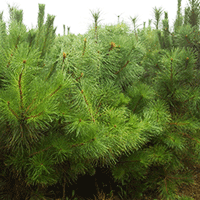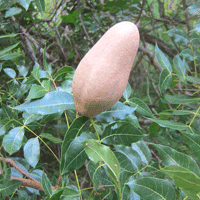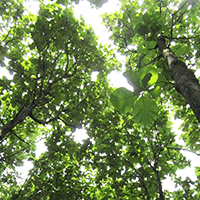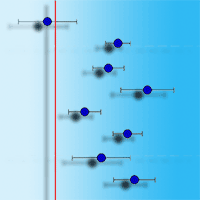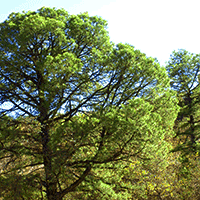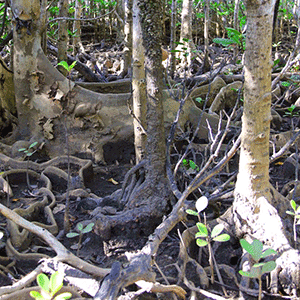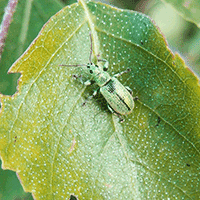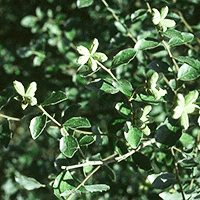Nutrient resorption (NuR) is an important nutrient conservative strategy but little information is available about the effect of nursery fertilization on NuR in the field. In this study, diploid and triploid one-year-old plants of Populus tomentosa Carr. were fertilized with 9 g N per plant, and non-fertilized plants as control. Initial functional attributes, i.e., height, diameter, stem mass, mineral nutrients and non-structural carbohydrate (NSC) levels of each tissue, were measured before planting. Field performance (survival, total height, diameter, stem volume and their growth, leaf nutrient status, and NuR) were measured in the field. Compared to control, 9 g N per plant was benefit for plant growth, mineral nutrients and NSC accumulation of diploids, but declined plant size of triploids before planting. While in the field, fertilization effect on plant size was inversed for each ploidy level. Nursery fertilization increased nitrogen resorption efficiency (NRE) of triploids and decreased phosphorus resorption efficiency (PRE) of both ploidy levels. Initial plant size were the most effective parameters predicting field performance and NuR. Furthermore, NRE was multi-elements controlled as indicated by the correlation of N and P in green and senesced leaves, while PRE was only positively correlated with P in green leaves. However, there was no relationship between field growth and NuR. This study deepened our understanding of NuR from the perspective of artificial managements, for instance nursery fertilization.
Keywords
, , , , ,
Citation
Wang M, Li G, Liu Y (2022). Nursery fertilization affected field performance and nutrient resorption of Populus tomentosa Carr. ploidy levels. iForest 15: 16-23. - doi: 10.3832/ifor3912-014
Academic Editor
Gianfranco Minotta
Paper history
Received: Jun 24, 2021
Accepted: Nov 17, 2021
First online: Jan 24, 2022
Publication Date: Feb 28, 2022
Publication Time: 2.27 months
© SISEF - The Italian Society of Silviculture and Forest Ecology 2022
Open Access
This article is distributed under the terms of the Creative Commons Attribution-Non Commercial 4.0 International (https://creativecommons.org/licenses/by-nc/4.0/), which permits unrestricted use, distribution, and reproduction in any medium, provided you give appropriate credit to the original author(s) and the source, provide a link to the Creative Commons license, and indicate if changes were made.

Breakdown by View Type
(Waiting for server response...)
Article Usage
Total Article Views: 31252
(from publication date up to now)
Breakdown by View Type
HTML Page Views: 26890
Abstract Page Views: 2269
PDF Downloads: 1632
Citation/Reference Downloads: 1
XML Downloads: 460
Web Metrics
Days since publication: 1416
Overall contacts: 31252
Avg. contacts per week: 154.49
Article Citations
Article citations are based on data periodically collected from the Clarivate Web of Science web site
(last update: Mar 2025)
Total number of cites (since 2022): 2
Average cites per year: 0.50
Publication Metrics
by Dimensions ©
Articles citing this article
List of the papers citing this article based on CrossRef Cited-by.
(1)
Aerts R (1996)Nutrient resorption from senescing leaves of perennials: are there general patterns? The Journal of Ecology 84 (4): 597-608.
CrossRef |
Gscholar
(2)
Allen S (1974)Chemical analysis of ecological materials. Blackwell Scientific, Oxford, UK, pp. 575.
Gscholar
(3)
Brant AN, Chen HYH (2015)Patterns and mechanisms of nutrient resorption in plants. Critical Reviews in Plant Sciences 34 (5): 471-486.
CrossRef |
Gscholar
(4)
Cao B, Gong Q, Qi Q (2004)Study on effects of different fertilizer scheme on seedlings of triploid
Populus tomentosa. Journal of Shandong Agricultural University (Natural Science) 35: 512-516. [in Chinese]
CrossRef |
Gscholar
(5)
Cleveland CC, Houlton BZ, Smith WK, Marklein AR, Reed SC, Parton W, Del Grosso SJ, Running SW (2013)Patterns of new
versus recycled primary production in the terrestrial biosphere. Proceedings of the National Academy of Sciences USA 110 (31): 12733-12737.
CrossRef |
Gscholar
(6)
Crane WJB, Banks JCG (1992)Accumulation and retranslocation of foliar nitrogen in fertilised and irrigated
Pinus radiata. Forest Ecology and Management 52 (1-4): 201-223.
CrossRef |
Gscholar
(7)
Cuesta B, Villar-Salvador P, Puértolas J, Jacobs DF, Rey Benayas JM (2010)Why do large, nitrogen rich seedlings better resist stressful transplanting conditions? A physiological analysis in two functionally contrasting Mediterranean forest species. Forest Ecology and Management 260: 71-78.
CrossRef |
Gscholar
(8)
Dong W, Qin J, Li J, Zhao Y, Nie L, Zhang Z (2011)Interactions between soil water content and fertilizer on growth characteristics and biomass yield of Chinese white poplar (
Populus tomentosa Carr.) seedlings. Soil Science and Plant Nutrition 57 (2): 303-312.
CrossRef |
Gscholar
(9)
Fortier J, Truax B, Gagnon D, Lambert F (2017)Linking biomass productivity to genotype-specific nutrient cycling strategies in mature hybrid poplars planted along an environmental gradient. BioEnergy Research 10 (3): 876-890.
CrossRef |
Gscholar
(10)
Fu Y, Oliet JA, Li G, Wang J (2017)Effect of controlled release fertilizer type and rate on mineral nutrients, non-structural carbohydrates, and field performance of Chinese pine container-grown seedlings. Silva Fennica 51 (2): 1-13.
CrossRef |
Gscholar
(11)
Gan H, Jiao Y, Jia J, Wang X, Li H, Shi W, Peng C, Polle A, Luo Bin Z (2015)Phosphorus and nitrogen physiology of two contrasting poplar genotypes when exposed to phosphorus and/or nitrogen starvation. Tree Physiology 36 (1): 22-38.
CrossRef |
Gscholar
(12)
Grossnickle SC (2012)Why seedlings survive: influence of plant attributes. New Forests 43 (5-6): 711-738.
CrossRef |
Gscholar
(13)
Grossnickle SC, MacDonald JE (2018)Why seedlings grow: influence of plant attributes. New Forests 49 (1): 1-34.
CrossRef |
Gscholar
(14)
Harvey HP, Van Den Driessche R (1999)Poplar nutrient resorption in fall or drought: influence of nutrient status and clone. Canadian Journal of Forest Research 29: 1916-1925.
CrossRef |
Gscholar
(15)
Heredia-Guerrero N, Oliet JA, Villar-Salvador P, Benito LF, Peñuelas JL (2014)Fertilization regime interacts with fall temperature in the nursery to determine the frost and drought tolerance of the Mediterranean oak
Quercus ilex subsp.
ballota. Forest Ecology and Management 331 (5): 50-59.
CrossRef |
Gscholar
(16)
Ji H, Wen J, Du B, Sun N, Berg B, Liu C (2018)Comparison of the nutrient resorption stoichiometry of
Quercus variabilis Blume growing in two sites contrasting in soil phosphorus content. Annals of Forest Science 75 (2): 597.
CrossRef |
Gscholar
(17)
Knoth JL, Kim SH, Ettl GJ, Doty SL (2014)Biological nitrogen fixation and biomass accumulation within poplar clones as a result of inoculations with diazotrophic endophyte consortia. New Phytologist 201 (2): 599-609.
CrossRef |
Gscholar
(18)
Kobe RK, Lepczyk CA, Iyer M (2005)Resorption efficiency decreases with increasing green leaf nutrients in a global data set. Ecology 86: 2780-2792.
CrossRef |
Gscholar
(19)
Lambers H, Chapin III, Pons TL (2008)Plant physiological ecology (2nd edn). Springer, New York, USA, pp. 248-249.
Gscholar
(20)
Li G, Zhu Y, Liu Y, Wang J, Liu J, Dumroese RK (2014)Combined effects of pre-hardening and fall fertilization on nitrogen translocation and storage in
Quercus variabilis seedlings. European Journal of Forest Research 133 (6): 983-992.
CrossRef |
Gscholar
(21)
Liao T, Cheng S, Zhu X, Min Y, Kang X (2016)Effects of triploid status on growth, photosynthesis, and leaf area in
Populus. Trees 30: 1137-1147.
CrossRef |
Gscholar
(22)
Lowther J (1980)Use of a single sulphuric-hydrogen peroxide digest for the analysis of
Pinus radiata needles. Communications in Soil Science and Plant Analysis 11 (2): 175-188.
CrossRef |
Gscholar
(23)
Luo J, Li H, Liu T, Polle A, Peng C, Luo Bin Z (2013)Nitrogen metabolism of two contrasting poplar species during acclimation to limiting nitrogen availability. Journal of Experimental Botany 64 (14): 4207-4224.
CrossRef |
Gscholar
(24)
Masclaux-Daubresse C, Daniel-Vedele F, Dechorgnat J, Chardon F, Gaufichon L, Suzuki A (2010)Nitrogen uptake, assimilation and remobilization in plants: challenges for sustainable and productive agriculture. Annals of Botany 105 (7): 1141-1157.
CrossRef |
Gscholar
(25)
Millard P, Grelet GA (2010)Nitrogen storage and remobilization by trees: ecophysiological relevance in a changing world. Tree Physiology 30 (9): 1083-1095.
CrossRef |
Gscholar
(26)
Nambiar EKS, Fife DN (1991)Nutrient retranslocation in temperate conifers. Tree Physiology 9 (1-2): 185-207.
CrossRef |
Gscholar
(27)
Oliet JA, Planelles R, Artero F, Valverde R, Jacobs DF, Segura ML (2009)Field performance of
Pinus halepensis planted in Mediterranean arid conditions: relative influence of seedling morphology and mineral nutrition. New Forests 37 (3): 313-331.
CrossRef |
Gscholar
(28)
Oliet JA, Puértolas J, Planelles R, Jacobs DF (2013)Nutrient loading of forest tree seedlings to promote stress resistance and field performance: a Mediterranean perspective. New Forests 44 (5): 649-669.
CrossRef |
Gscholar
(29)
Pasche F, Pornon A, Lamaze T (2002)Do mature leaves provide a net source of nitrogen supporting shoot growth in
Rhododendron ferrugineum? New Phytologist 154 (1): 99-105.
CrossRef |
Gscholar
(30)
Reich PB (2014)The world-wide “fast-slow” plant economics spectrum: a traits manifesto. Journal of Ecology 102 (2): 275-301.
CrossRef |
Gscholar
(31)
Reich PB, Walters MB, Ellsworth DS (1997)From tropics to tundra: global convergence in plant functioning. Proceedings of the National Academy of Sciences USA 94 (25): 13730-13734.
CrossRef |
Gscholar
(32)
Rogers A, McDonald K, Muehlbauer MF, Hoffman A, Koenig K, Newman L, Taghavi S, Van Der Lelie D (2012)Inoculation of hybrid poplar with the endophytic bacterium
Enterobacter sp. 638 increases biomass but does not impact leaf level physiology. GCB Bioenergy 4 (3): 364-370.
CrossRef |
Gscholar
(33)
Salehi A, Ghorbanzadeh N, Salehi M (2013)Soil nutrient status, nutrient return and retranslocation in poplar species and clones in northern Iran. iForest 6: 336-341.
CrossRef |
Gscholar
(34)
Sattler MC, Carvalho CR, Clarindo WR (2016)The polyploidy and its key role in plant breeding. Planta 243: 281-296.
CrossRef |
Gscholar
(35)
Sohrt J, Herschbach C, Weiler M (2018)Foliar P- but not N resorption efficiency depends on the P-concentration and the N: P ratio in trees of temperate forests. Trees 32 (5): 1443-1455.
CrossRef |
Gscholar
(36)
Van De Peer Y, Mizrachi E, Marchal K (2017)The evolutionary significance of polyploidy. Nature Reviews Genetics 18 (7): 411-424.
CrossRef |
Gscholar
(37)
Vergutz L, Manzoni S, Porporato A, Novais RF, Jackson RB (2012)Global resorption efficiencies and concentrations of carbon and nutrients in leaves of terrestrial plants. Ecological Monographs 82 (2): 205-220.
CrossRef |
Gscholar
(38)
Villar-Salvador P, Peñuelas JL, Nicolás-Peragón JL, Benito LF, Domínguez-Lerena S (2013)Is nitrogen fertilization in the nursery a suitable tool for enhancing the performance of Mediterranean oak plantations? New Forests 44 (5): 733-751.
CrossRef |
Gscholar
(39)
Villar-Salvador P, Planelles R, Enríquez E, Rubira JP (2004)Nursery cultivation regimes, plant functional attributes, and field performance relationships in the Mediterranean oak
Quercus ilex L. Forest Ecology and Management 196 (2-3): 257-266.
CrossRef |
Gscholar
(40)
Villar-Salvador P, Uscola M, Jacobs DF (2015)The role of stored carbohydrates and nitrogen in the growth and stress tolerance of planted forest trees. New Forests 46 (5-6): 813-839.
CrossRef |
Gscholar
(41)
Wang X, Huang J (2015)Principles and techniques of plant physiological biochemical experiment. Higher Education Press, Beijing, China, pp. 171-186. [In Chinese]
Gscholar
(42)
Wright IJ, Westoby M (2003)Nutrient concentration, resorption and lifespan: leaf traits of Australian sclerophyll species. Functional Ecology 17 (1): 10-19.
CrossRef |
Gscholar
(43)
Yan T, Lü X, Yang K, Zhu J (2016)Leaf nutrient dynamics and nutrient resorption: a comparison between larch plantations and adjacent secondary forests in Northeast China. Journal of Plant Ecology 9 (2): 165-173.
CrossRef |
Gscholar
(44)
Yan T, Zhu J, Yang K (2018)Leaf nitrogen and phosphorus resorption of woody species in response to climatic conditions and soil nutrients: a meta-analysis. Journal of Forestry Research 29 (4): 905-913.
CrossRef |
Gscholar
(45)
Yuan ZY, Chen HYH (2015)Concepts and synthesis. Ecology 96 (2): 373-380.
CrossRef |
Gscholar
(46)
Yuan ZY, Chen HYH (2009)Global-scale patterns of nutrient resorption associated with latitude, temperature and precipitation. Global Ecology and Biogeography 18 (1): 11-18.
CrossRef |
Gscholar
(47)
Zeng Y, Fang X, Xiang W, Deng X, Peng C (2017)Stoichiometric and nutrient resorption characteristics of dominant tree species in subtropical Chinese forests. Ecology and Evolution 7 (24): 11033-11043.
CrossRef |
Gscholar
(48)
Zhang P, Wu F, Kang X (2013)Genetic control of fiber properties and growth in triploid hybrid clones of
Populus tomentosa. Scandinavian Journal of Forest Research 28 (7): 621-630.
CrossRef |
Gscholar
(49)
Zhang JL, Zhang SB, Chen YJ, Zhang YP, Poorter L (2015)Nutrient resorption is associated with leaf vein density and growth performance of dipterocarp tree species. Journal of Ecology 103 (3): 541-549.
CrossRef |
Gscholar
(50)
Zhao X, Li Y, Zheng M, Bian X, Liu M, Sun Y, Jiang J, Wang F, Li S, Cui Y, Liu G, Yang C (2015)Comparative analysis of growth and photosynthetic characteristics of (
Populus simonii × P. nigra) × (
P. nigra × P. simonii) hybrid clones of different ploidides. PLoS One 10: 1-16.
CrossRef |
Gscholar
(51)
Zheng S, Gao R, Liu F (2009)Poplar cultivation. Golden Shield Publishing House, Beijing, China, pp. 92-108. [In Chinese]
Gscholar
(52)
Zhou L, Addo-Danso SD, Wu P, Li S, Zou X, Zhang Y, Ma X (2016)Leaf resorption efficiency in relation to foliar and soil nutrient concentrations and stoichiometry of
Cunninghamia lanceolata with stand development in southern China. Journal of Soils and Sediments 16 (5): 1448-1459.
CrossRef |
Gscholar
(53)
Zhu, Z, Lin H, Kang X (1995)Studies on allotriploid breeding of Populus tomentosa B301 clones. Scientia Silvae Sinicae 31 (6): 499-505.
Online |
Gscholar
(54)
Zhu Z (2006)Breeding of triploid Populus tomentosa. In: “Genetic Improvement of
Populus tomentosa” (Zhu Z ed). Chinese Forestry Press, Beijing, China, pp. 155-220.
Gscholar



